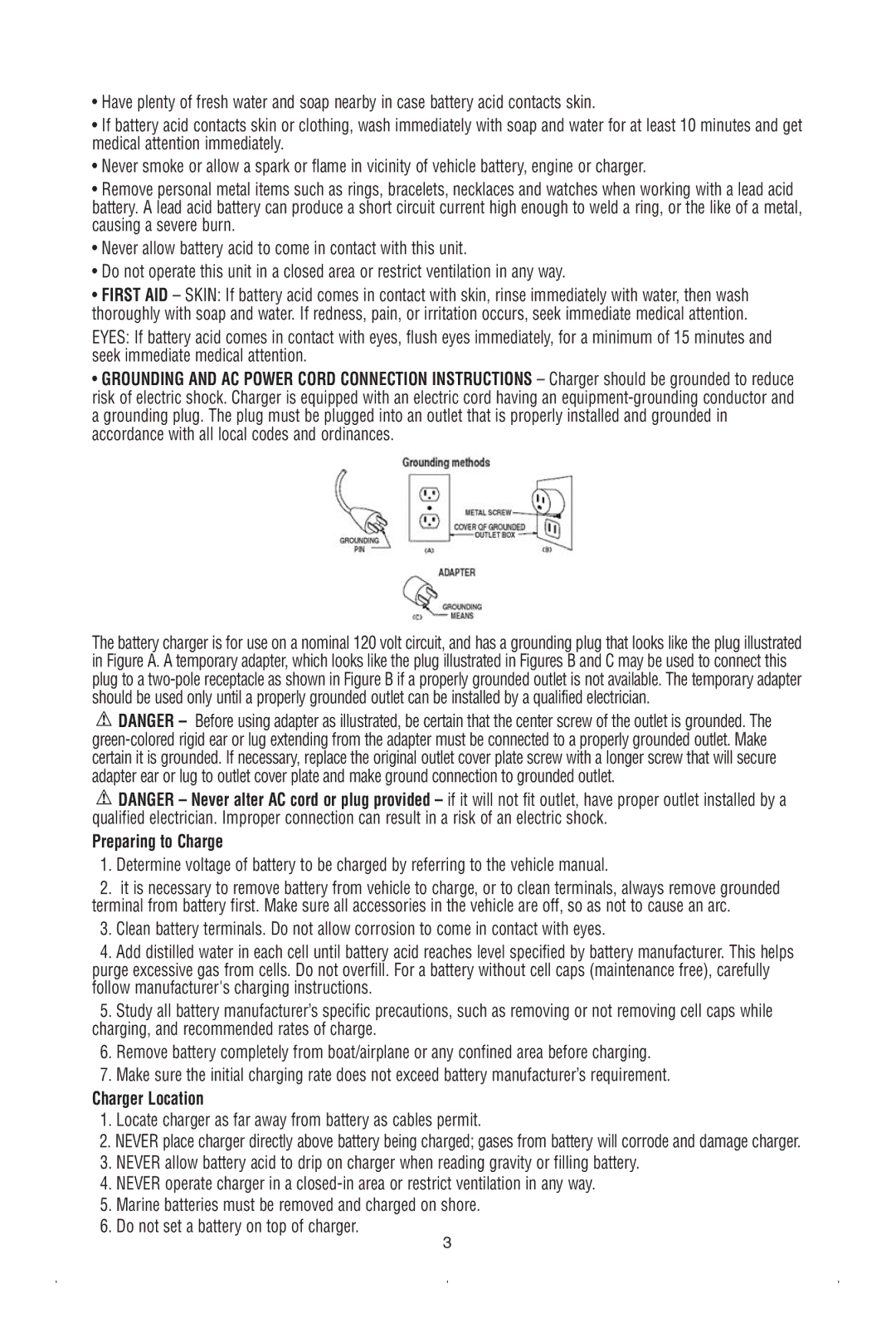
•Have plenty of fresh water and soap nearby in case battery acid contacts skin.
•If battery acid contacts skin or clothing, wash immediately with soap and water for at least 10 minutes and get medical attention immediately.
•Never smoke or allow a spark or flame in vicinity of vehicle battery, engine or charger.
•Remove personal metal items such as rings, bracelets, necklaces and watches when working with a lead acid battery. A lead acid battery can produce a short circuit current high enough to weld a ring, or the like of a metal, causing a severe burn.
•Never allow battery acid to come in contact with this unit.
•Do not operate this unit in a closed area or restrict ventilation in any way.
•FIRST AID – SKIN: If battery acid comes in contact with skin, rinse immediately with water, then wash thoroughly with soap and water. If redness, pain, or irritation occurs, seek immediate medical attention.
EYES: If battery acid comes in contact with eyes, flush eyes immediately, for a minimum of 15 minutes and seek immediate medical attention.
•GROUNDING AND AC POWER CORD CONNECTION INSTRUCTIONS – Charger should be grounded to reduce risk of electric shock. Charger is equipped with an electric cord having an
The battery charger is for use on a nominal 120 volt circuit, and has a grounding plug that looks like the plug illustrated in Figure A. A temporary adapter, which looks like the plug illustrated in Figures B and C may be used to connect this plug to a
![]() DANGER – Before using adapter as illustrated, be certain that the center screw of the outlet is grounded. The
DANGER – Before using adapter as illustrated, be certain that the center screw of the outlet is grounded. The
![]() DANGER – Never alter AC cord or plug provided – if it will not fit outlet, have proper outlet installed by a qualified electrician. Improper connection can result in a risk of an electric shock.
DANGER – Never alter AC cord or plug provided – if it will not fit outlet, have proper outlet installed by a qualified electrician. Improper connection can result in a risk of an electric shock.
Preparing to Charge
1.Determine voltage of battery to be charged by referring to the vehicle manual.
2.it is necessary to remove battery from vehicle to charge, or to clean terminals, always remove grounded terminal from battery first. Make sure all accessories in the vehicle are off, so as not to cause an arc.
3.Clean battery terminals. Do not allow corrosion to come in contact with eyes.
4.Add distilled water in each cell until battery acid reaches level specified by battery manufacturer. This helps purge excessive gas from cells. Do not overfill. For a battery without cell caps (maintenance free), carefully follow manufacturer's charging instructions.
5.Study all battery manufacturer’s specific precautions, such as removing or not removing cell caps while charging, and recommended rates of charge.
6.Remove battery completely from boat/airplane or any confined area before charging.
7.Make sure the initial charging rate does not exceed battery manufacturer’s requirement.
Charger Location
1.Locate charger as far away from battery as cables permit.
2.NEVER place charger directly above battery being charged; gases from battery will corrode and damage charger.
3.NEVER allow battery acid to drip on charger when reading gravity or filling battery.
4.NEVER operate charger in a
5.Marine batteries must be removed and charged on shore.
6.Do not set a battery on top of charger.
3
